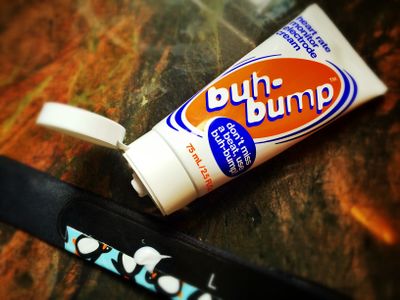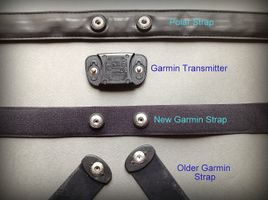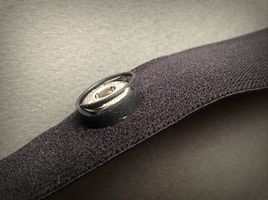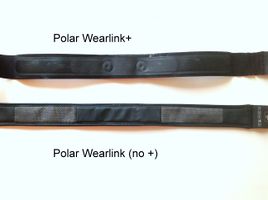Difference between revisions of "Fixing Heart Rate Monitor Problems"
User:Fellrnr (User talk:Fellrnr | contribs) (→Fixing other problems) |
User:Fellrnr (User talk:Fellrnr | contribs) |
||
| Line 1: | Line 1: | ||
| − | + | There are two main problems with [[Best Running Watch| Garmin's]] [[Heart Rate Monitor| Heart Rate Monitoring]]; poor accuracy and chaffing, and there are two simple fixes. The first fix is to apply a little [http://www.amazon.com/Buh-Bump-2-5-Ounce-Heart-Monitor-Electrode/dp/B000HZD2NU Buh-Bump Electrode Cream], which improves the accuracy and provides some lubrication that reduces chaffing. The other fix is to apply some duct tape to the bottom edge of the strap, which works wonders at preventing chaffing. I had no chaffing problems with a duct taped strap during the 37 hours I was running [[2014_Badwater_135| Badwater]]. | |
| + | {| class="wikitable" | ||
| + | |- valign="top" | ||
| + | |[[File:BuhBump.JPG|right|thumb|x300px|Buh-Bump and Duct Tape can fix your Garmin Heart Rate woes.]] | ||
| + | |[[File:GarminDuctTape1.JPG|none|thumb|x300px|Apply the duct tape to the lower edge of the back side of the strap. Don't cover the electrodes or you won't get a signal, but you'll need the tape to be on the lower edge to get good adhesion. You will need a strip of duct tape about an inch wide.]] | ||
| + | |[[File:GarminDuctTape2.JPG|none|thumb|x300px| Fold the duct tape up over the front of the strap. You can stick it to the transmitter as shown in this picture, which gives it good adhesion.]] | ||
| + | |} | ||
| + | =Using the Polar Wearlink Strap= | ||
| + | You can get a fabric [http://www.amazon.com/dp/B000F7F64I Polar Wearlink Replacement Strap] that works nicely with the Garmin transmitter. However, Polar replaced the Wearlink strap with the Wearlink+, so the original design is hard to come by. (The new Wearlink+ is nearly identical to the Garmin strap and not worth the upgrade.) | ||
<gallery widths=300px heights=200px caption="[[Heart Rate Monitor]] Straps" perrow="3"> | <gallery widths=300px heights=200px caption="[[Heart Rate Monitor]] Straps" perrow="3"> | ||
File:Garmin and Polar HRM Tx.jpg|The Polar and Garmin Heart Rate Transmitters, showing the similarity in connectors. | File:Garmin and Polar HRM Tx.jpg|The Polar and Garmin Heart Rate Transmitters, showing the similarity in connectors. | ||
| Line 5: | Line 13: | ||
File:Garmin and Polar Straps Back.jpg|The back of the various straps. You can see the Polar has absorbent electrodes that work remarkably well, where the Garmin straps use a hard plastic electrode. The Polar strap is also more comfortable than either of the Garmin straps. | File:Garmin and Polar Straps Back.jpg|The back of the various straps. You can see the Polar has absorbent electrodes that work remarkably well, where the Garmin straps use a hard plastic electrode. The Polar strap is also more comfortable than either of the Garmin straps. | ||
File:PolarStrapMod.JPG|The Wearlink+ Polar strap has plastic surrounding the attachment clip that stops the Garmin transmitter clicking in place fully. Simply trim off the extra plastic with scissors and the Garmin will connect solidly. This picture shows the excess partly removed. | File:PolarStrapMod.JPG|The Wearlink+ Polar strap has plastic surrounding the attachment clip that stops the Garmin transmitter clicking in place fully. Simply trim off the extra plastic with scissors and the Garmin will connect solidly. This picture shows the excess partly removed. | ||
| − | File:Polar Wearlinks.jpg|At the top you can see the newer [http://www.amazon.com/dp/B007XCLU66 Wearlink+] and the older [http://www.amazon.com/dp/B004RCLGHI/ Wearlink] on the bottom. The Wearlink has pads that are absorbent so you | + | File:Polar Wearlinks.jpg|At the top you can see the newer [http://www.amazon.com/dp/B007XCLU66 Wearlink+] and the older [http://www.amazon.com/dp/B004RCLGHI/ Wearlink] on the bottom. The Wearlink has pads that are absorbent so you don't have a problem with them drying out, but the Wearlink+ seems to be slightly more reliable. |
</gallery> | </gallery> | ||
=Fixing other problems= | =Fixing other problems= | ||
There are a number of problems you can still get with the Garmin Heart Rate Monitoring | There are a number of problems you can still get with the Garmin Heart Rate Monitoring | ||
| − | + | * Unlike the Polar system, the contacts on the Garmin transmitter tend to rust, so it's important to disconnect the transmitter from the strap after each use. You can see a little of the rust in the picture above. | |
| − | * Unlike the Polar system, the contacts on the transmitter tend to rust, so it's important to disconnect the transmitter from the strap after each use. You can see a little of the rust in the picture above. | ||
* If you do get rust on the transmitter connecters, then a wire brush can fix the problem. I used these [http://go.fellrnr.com?id=35454X937677&xs=1&xcust=WireBrush&url=http%3A%2F%2Fwww.amazon.com%2Fgp%2Fproduct%2FB005XASFSG small brushes] that worked well for me. | * If you do get rust on the transmitter connecters, then a wire brush can fix the problem. I used these [http://go.fellrnr.com?id=35454X937677&xs=1&xcust=WireBrush&url=http%3A%2F%2Fwww.amazon.com%2Fgp%2Fproduct%2FB005XASFSG small brushes] that worked well for me. | ||
| − | |||
* A low battery can result in bad reception, and the watch does not always report a low battery condition properly. | * A low battery can result in bad reception, and the watch does not always report a low battery condition properly. | ||
* When replacing the battery, insert the new one upside down for a few minutes to short out the contacts. This will reset the monitor and may prevent some reception problems. | * When replacing the battery, insert the new one upside down for a few minutes to short out the contacts. This will reset the monitor and may prevent some reception problems. | ||
Revision as of 16:29, 7 September 2014
There are two main problems with Garmin's Heart Rate Monitoring; poor accuracy and chaffing, and there are two simple fixes. The first fix is to apply a little Buh-Bump Electrode Cream, which improves the accuracy and provides some lubrication that reduces chaffing. The other fix is to apply some duct tape to the bottom edge of the strap, which works wonders at preventing chaffing. I had no chaffing problems with a duct taped strap during the 37 hours I was running Badwater.
1 Using the Polar Wearlink Strap
You can get a fabric Polar Wearlink Replacement Strap that works nicely with the Garmin transmitter. However, Polar replaced the Wearlink strap with the Wearlink+, so the original design is hard to come by. (The new Wearlink+ is nearly identical to the Garmin strap and not worth the upgrade.)
- Heart Rate Monitor Straps
2 Fixing other problems
There are a number of problems you can still get with the Garmin Heart Rate Monitoring
- Unlike the Polar system, the contacts on the Garmin transmitter tend to rust, so it's important to disconnect the transmitter from the strap after each use. You can see a little of the rust in the picture above.
- If you do get rust on the transmitter connecters, then a wire brush can fix the problem. I used these small brushes that worked well for me.
- A low battery can result in bad reception, and the watch does not always report a low battery condition properly.
- When replacing the battery, insert the new one upside down for a few minutes to short out the contacts. This will reset the monitor and may prevent some reception problems.
- A factory (master) reset of the watch may be required. I found this fixed a number of problems with my 310XT, including heart rate monitoring.
- The straps can be damaged by washing and require careful hand washing, not machine washing. If you damage a strap, it needs replacement.
- Interference from overhead power lines used to be a problem, but the modern systems have reduced this dramatically.
- All of the soft straps require periodic replacement, so you may need a new one.







